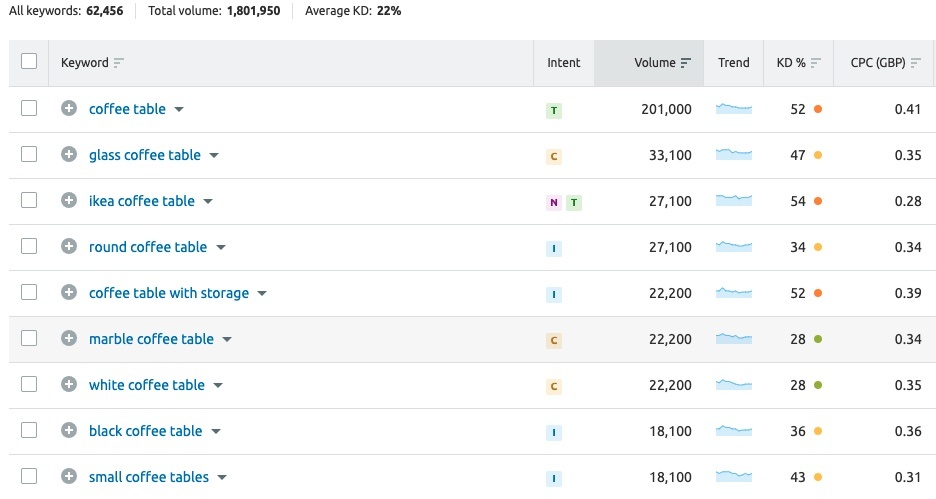SEO Tip – Spend Some Time on SERPS
SEO Tip: One of the most important aspects of any successful keyword research project is to actually spend some time in Google completing searches. You can use any tool you want to research search volumes, competition, and so on, but none of them will provide you with a clear picture of what a keyword's search intent is or what's really going on in the SERP (Search Engine Results Page).
Most also won't tell you what kinds of SERP results Google are displaying. It's difficult to obtain a solid idea of the actual problems consumers are seeking to solve when searching for a specific query without looking at the actual SERPs and results on page one.
The Semrush Tool has recently added a ‘Search Intent' feature to its reports on SERPS. This is a very useful function indeed, allowing you to filter keyword lists by intent.
- Commercial – The user wants to investigate brands or services.
-
Informational – The user wants to find an answer to a specific question.
-
Navigational – The user wants to find a specific page or site.
-
Transactional – The user wants to complete an action (conversion).
Whilst the Semrush Tool is invaluable for anyone doing serious SEO, it will never beat an experienced human! Take a look at the results Google returns whether you choose a new term to target or opt to revisit an old piece of content to update it.
A quick search in Semrush for ‘coffee table' shows how the software reports on search intent.
There are a few things to keep in mind.
- Look for featured snippets on Google.
- If a featured snippet appears at the top of the search results, you should examine the query and the featured snippet closely.
- Is it a complete response to the question? If it does, the search results below, including the first organic position, are likely to be underutilised. Take this into consideration. If the featured snippet isn't replaced, the keyword is unlikely to get much traffic.
- A search for “How tall is Mount Everest” is a basic example of what I'm talking about… The answer of 29,032 feet is immediately displayed by Google.
- This is a simplified example, but there are other questions to consider. “What size X should I use for Y,” for example, may be a search term. A featured excerpt will solve the problem if the answer is straightforward and does not require more explanation. There will be very few clicks on the results below.
- Google frequently changes the way it displays SERPS and this can vary amongst regions, sectors, and industries. It constantly runs tests and experiments, so check the SERPS regularly.
You should also pay attention to the kind of articles that are ranking.
Articles that are ranking: Is it product listings that you're looking for? Tutorials? Lists? What about service pages? This will give you a decent idea of what Google considers to be the most common search intent for the query and which search results it favours. What types of websites are ranked? Is the majority of the traffic coming from news sites? Are there any local businesses? Directories? Pages on a blog?
This may also provide some insight into what Google considers to be the search intent. If you notice a lot of directories in a search result, for example, that could indicate that the search aim is to discover a list of places that can provide a solution. This is typical of many local searches.
How far down the page do you have to scroll to see the first organic search result?
- When people are perplexed as to why their high-ranking page isn't generating more traffic, this is frequently the reason.
- Keep this in mind if you see a featured snippet followed by advertisements, a ‘people also inquire' box and then organic results. Even if you rank first in the organic results, you are unlikely to receive the 45-70 percent of clicks that a first-place ranking often brings.
- Clicks will be sucked away by all of the other distractions.
This can be done on both a desktop and a mobile device.
How far will Users scroll down a page to check SERPS?
On a search engine results page, the average online user will only look at the first five listings (SERP). According to a 2014 study by Advanced Web Rankings, the top five results receive almost 67 percent of all SERP visits. When you go past the first few results, things start to seem bleak. According to research, the first search engine results page receives over 95% of all web traffic, with the subsequent search results pages receiving only 5%.
What Is the Importance of SERP Position?
When a search engine result catches the eye of a web user, the logical next step is for the user to visit the website to learn more and possibly take some action (such as making a purchase). Because they've found what they're looking for, don't want to read any further, or are short on time, most individuals will click on one of the first few results. As a result, the better the organic search ranking of a company, the higher the click-through rate (CTR). According to a Google organic desktop search study from July 2014, page one results have a CTR of 71%, whereas pages two and three have a combined CTR of only 6%.
We're all focused on user experience on our websites these days, but few of us think to check out the SERPs' user experience.
What are the current challenges for organic search results?
Search engine marketers must be concerned about more than simply their competitors' organic listings. Google changes its SERP format regularly, and the first organic first result may be pushed below a local 3-pack, a featured snippet, or up to four text ads, depending on the search query. When it comes to organic CTR, the inclusion of advertising can make a big difference. When there are no advertisements on SERPs, the average CTR for the first organic result is 30%, but when ads are there, it reduces to 17.9%.
When businesses compete for long-tail keywords (phrases that contain at least three words), they risk losing real estate to Google's new highlighted snippet. A featured snippet is a block near the top of the SERP that selects a few lines and a link from a high-ranking website to answer a searcher's question.
Try to look at a SERP objectively.
- What are some of the recurring topics in the search results? What improvements could you make to your page to better serve searchers? Forget about your own biases and what you believe is best. What can you do to make your page more Google-friendly?
- When attempting to identify ranking declines, this method can be effective.
- The user intent for a search query might change over time, or, more precisely, Google's perception of it can alter based on fresh data.
- If you notice a decline in traffic, it's possible that it's because Google is now displaying a highlighted snippet where it wasn't before. Perhaps a box labelled “people also ask” appeared in the search results.
- If you notice a reduction in rankings, compare the SERPs to what they were previously. Perhaps, over time, the search results have evolved away from instructional and toward more items and services, or perhaps the search purpose has shifted in another direction.
- It's not usually because you did anything incorrect or because competition overtook you that your ranking and traffic dropped. They can occur as a result of new ‘features' appearing in the SERPs ahead of you or as the search intent shifts.
Spending some time in the SERPs can help you do your work faster.
What Strategies Can You Use to Compete for Organic Traffic?
Your company needs to invest in search engine optimisation (SEO) tactics that will assist your site to attain SERP visibility as it gets more difficult to rank effectively for industry-relevant search queries.
Here are a few ideas to get you started:
- Look for long-tail keywords with low competition and strong traffic. The greater the competition for a term, the more difficult it will be to rank on page one. You'll have a higher chance of getting in front of the online users who need your product or service if you focus on long-tail keywords that are particular to your business.
- Determine the types of questions that your target audience is asking (and that are relevant to your business). If you provide detailed answers to those queries in blog posts or knowledge hub pages on your website, your information could be featured in a featured snippet.
- Work with a web development company to improve your site's technical aspects. Improving your site's performance and making sure all of your pages are mobile-friendly will help you rank higher in search engines.
- Make sure your title tags and meta descriptions are optimised. The preview of your content that online consumers will see on a SERP is made up of your title tag and meta description, so make sure they provide a compelling incentive to click. It can also help you rank higher for relevant search queries if you include a primary keyword in both the title and description.
- Users will notice their website links if companies pay attention to their search engine optimization techniques, resulting in higher click-through rates, greater visibility in the SERPs, and more consumers.
Check out some awesome tips on Social Media Marketing
About The Author
Chris Giles is the owner of CGain Web Design & SEO and has been involved in the internet industry since the early 1990s. He has been the marketing manager of several multi-million turnover companies. He is a Fellow of The Chartered Institute of Marketing (FCIM) and a Fellow of The Institute of Data and Marketing (F IDM).






Comments are closed